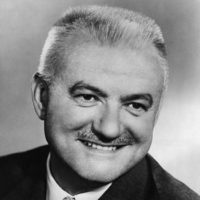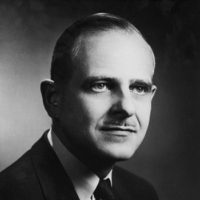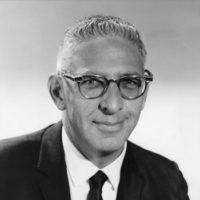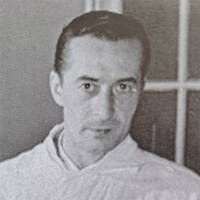
Robert H. Noce
Modesto State Hospital

Pierre Deniker
Sainte-Anne Psychiatric Hospital

Heinz E. Lehmann
Douglas Hospital, Montréal

Nathan S. Kline
Rockland Psychiatric Center (Rockland State Hospital)

Henri Laborit
Val-de-Grâce
For studies of the use of reserpine in the treatment of certain mental illnesses.
Nathan Kline
For his outstanding work since early in 1953, bringing to the attention of American and European psychiatrists the value of Rauwolfia derivatives and especially reserpine in the treatment of mental and nervous disorders. Many have contributed to the final result; the original story can be traced back into the medicine of ancient India, and a number of research workers were involved in various ways during the final phases of the development. But the large-scale use of reserpine in mental hospitals everywhere is more closely linked with the name of Dr. Nathan Kline than that of any other investigator.
As director of the research division of Rockland State Hospital, he designed, organized, and directed the large-scale study which was made in the wards there, and which was the basis for a series of reports on Rauwolfiaand reserpine that soon had widespread confirmation. Coming when the clinical results of chlorpromazine therapy were just beginning to be recognized in this country, these new data greatly reinforced the case for drugs as a treatment for mental disorder.
No facet of mental hospital life has been left untouched by this new form of treatment. At last we are in a position to apply the more liberal policies often previously tried but never maintained long on a large scale; architecture, methods of admission and discharge, hospital organization, public relations, training of employees and staff, and the whole practice and theory of psychiatry have been significantly influenced.
Robert Noce
Among the investigations undertaken almost simultaneously in various psychiatric settings as soon as reserpine became available was that of Dr. Robert Noce, director of clinical services at the Modesto State Hospital, California. The work began in May 1953, and the account published in 1954 is a valuable documentation of the techniques of treatment, the nature of side reactions and of the individual and overall results. This paper is particularly significant because Dr. Noce saw not only the potentialities of reserpine as a treatment for the mentally ill in state hospitals, but also understood the inner relationship between these problems and those encountered among mental defectives in state schools; for the first time, somatic therapy was to have more than token acknowledgment as a method of treatment for these cases. It represented a great advance in the humane and constructive care of the disturbed defective, putting this form of therapy on a practical basis and demonstrating that tranquilizing drugs have a place in state schools, though less extensive than in state hospitals, and representing an important move in the closer integration of the psychiatric problems of mental deficiency with those of general psychiatry.
For the development of chlorpromazine as a therapeutic agent in schizophrenia.
Pierre Deniker
The introduction of chlorpromazine into psychiatry was primarily the work of Dr. Pierre Deniker, of Paris, France. It was he and his co-workers who clearly pointed out that this drug alone, without the aid of other somatic therapies, could be effective in the treatment of illness.
In a rapid series of communications which began in May 1952, he developed the thesis that it was possible to secure good therapeutic responses from this treatment which produced relaxation and rest, the opposite of the irritating and stimulating effects of shock methods. He boldly abandoned dependence on hibernation therapy and prolonged sleep, previously considered essential for such work with other drugs, and since then thousands of papers have appeared to attest to the soundness of this concept demonstrated in millions of patients.
This work firmly established a whole new phase of psychiatric treatment and research. It demonstrated on a vast scale and incontrovertibly that a medication could influence the clinical course of the major psychoses; the problems of psychiatry had been brought within reach of the experimental laboratory as never before, and the future was suddenly more bright and promising.
Henri Laborit
It was Dr. Henri Laborit of Paris, France, who first applied chlorpromazine as a therapeutic agent. Primarily interested in a method of preventing surgical shock and postoperative illness, he carried out a long series of experiments, combining into a "lytic cocktail" the various known medications which might block the entrance of harmful stimuli of each of the various levels of the nervous system, always searching for newer and better compounds to increase the effectiveness of the mixture. Following the trail through various aspects of potentiated anesthesia and artificial hibernation, he finally secured a new phenothiazine derivative, RP 4560 (chlorpromazine), of which he wrote its "properties prove more remarkable every day." He recognized its decisively central action and made the following penetrating observation: "From the unusual central action, it may be deduced that [chlorpromazine] can be used for certain indications in psychiatry." How well this prediction was borne out is now a matter of medical history.
The clues which led to the final identification of chlorpromazine had been available to others for some time and had even been investigated in a tentative way, but it was Dr. Laborit who recognized their true meaning, followed them to a discovery of first importance and grasped the implications of that discovery for clinical psychiatry. Thus a discovery in technique of anesthesia proved important for mental illness and illustrated again the essential unity of medicine with psychiatry, at the same time supplying a method by which this unity could be implemented as never before.
Heinz Lehmann
Dr. Heinz Lehmann, in a single scholarly paper in February 1954 with Dr. G.E. Hanrahan, brought the full practical significance of chlorpromazine to the attention of the Western Hemisphere after it had been left unnoted, except by certain small investigative groups, for almost two years. In his first important publication on the subject, Dr. Lehmann was able to outline the clinical guidelines so clearly, describe the results so accurately and evaluate the dangers so frankly that, with this paper alone, any other psychiatrist was in a position to apply this medication with confidence and safety. He noted not only the effect on the individual patient but the overall ward effect on groups, and especially disturbed wards. The paper was so written that the method was easily open to repetition for confirmation or refutation, as the case might be; confirmation was so rapid and complete that for a time data outran formal publication and much that went on in the next year or two became known by word of mouth and personal communication, only reaching print considerably later. The application in volume of this method, together with that of reserpine, is generally credited with the sudden change of the overall United States Mental Hospital Census, which, in 1955–1956, fell by 7,000 instead of the expected gain of over 10,000.
Dr. Lehman's work with chlorpromazine represents a major contribution to American psychiatry.
